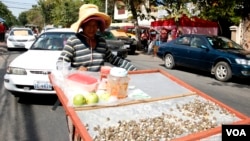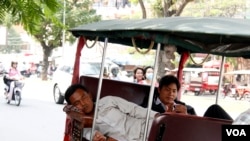PHNOM PENH —
An increasing number of Cambodians see themselves faring worse, a Gallup polls suggests.
In a global survey released earlier this month, the US-based firm ranked Cambodia near the very bottom in terms of life satisfaction, and it found that 34 percent of surveyed Cambodians consider themselves “suffering.”
That figure, for 2012, is up from 26 percent of Cambodians who said the same thing the year before.
Despite the ever-increasing appearance of luxury SUVs on the streets of the capital, many Cambodians still face hardships in their daily lives.
“Now we’re both working all month for the whole month’s expenditures, even though we spend money carefully,” Vorn Bunny, a 41-year-old taxi driver for a private company, told VOA Khmer recently. “How can our living standard improve?”
Vorn Bunny and his wife, who is a garment worker, together earn a mere $180 per month. They have three children, and struggle against the rising cost of living, as well as inflation.
“When we get sick, we have no money, and we have to borrow money from the bank to pay for the hospital,” he said. “In 2013, my wife got sick and had surgery. I borrowed 2 million riel [about $500]. Nobody helped me.”
Now he has to work hard to pay off the debt, he said. He blamed poor governance and poor social and health services, along with high food prices and little opportunity for income.
Vorn Bunny is typical of Cambodians reflected in the Gallop poll, which asked respondents whether they were thriving, struggling or suffering.
Those who said they were “suffering” were “more likely to report lacking the basics of food and shelter, more likely to have physical pain, a lot of stress, worry, sadness, and anger,” according to the results of the poll. “They have less access to health insurance and care, and more than double the disease burden, compared to ‘striving’ respondents.”
Khem Ley, an independent social researcher, said the survey was reliable and reflected a poverty gap and inequality in Cambodian society. “Suffering is not just something happening now,” he said. “It has happened over the last five years, so Cambodians have no choice but to migrate to neighboring countries for labor, despite the risks.”
According to a regional survey in 2012, nearly 60 percent of Cambodians still earn less than $2 per day.
Moeun Tola, head of the labor rights program at the Community Legal Education Center, said poor working standards combine with no set minimum wage in sectors beyond garment factories to increase woes for everyday Cambodians. Accidents at work, lost jobs and illness can all be threatening for many people, he said.
However, Then Pagnathun, director-general at the Ministry of Planning, said he was skeptical of the poll. The ministry’s own studies show about 19 percent of Cambodians under the poverty line in 2011.
“To me, it is not quite clear how they did it, but it is not acceptable, as they surveyed a small number of people,” he said.
The government is moving toward better health and social services, reducing the hardships for people, he said. More funding has gone to healthcare, and more health centers have opened in remote areas, he said.
“Although the services are increasing, we cannot fill 100 percent what our people need,” he conceded. But he said as a policymaker, he sees services delivered to people in rural areas.
However, Khem Ley said government policy does not directly address poverty elimination. “What I am concerned with in this survey is that as people get poorer, there will be more robbery and crime,” he said.
About 65 percent of Cambodians are now in debt, he said. Natural disasters, rising costs for goods, population growth and a shrinking amount of land for people are all bad signs, he said.
Farmers don’t have enough land to produce the rice they need to survive, and Cambodians in debt cannot afford to pay it off. Government policy has overlooked economic developments that could help the poor and vulnerable, he said.
For Moeun Tola, the failures are apparent in the behavior of wealthier Cambodians.
“If the government says Cambodian health services are reliable, why do those government officials go to Thailand or Singapore for treatment?” he said.
In a global survey released earlier this month, the US-based firm ranked Cambodia near the very bottom in terms of life satisfaction, and it found that 34 percent of surveyed Cambodians consider themselves “suffering.”
That figure, for 2012, is up from 26 percent of Cambodians who said the same thing the year before.
Despite the ever-increasing appearance of luxury SUVs on the streets of the capital, many Cambodians still face hardships in their daily lives.
“Now we’re both working all month for the whole month’s expenditures, even though we spend money carefully,” Vorn Bunny, a 41-year-old taxi driver for a private company, told VOA Khmer recently. “How can our living standard improve?”
Vorn Bunny and his wife, who is a garment worker, together earn a mere $180 per month. They have three children, and struggle against the rising cost of living, as well as inflation.
“When we get sick, we have no money, and we have to borrow money from the bank to pay for the hospital,” he said. “In 2013, my wife got sick and had surgery. I borrowed 2 million riel [about $500]. Nobody helped me.”
Now he has to work hard to pay off the debt, he said. He blamed poor governance and poor social and health services, along with high food prices and little opportunity for income.
Vorn Bunny is typical of Cambodians reflected in the Gallop poll, which asked respondents whether they were thriving, struggling or suffering.
Those who said they were “suffering” were “more likely to report lacking the basics of food and shelter, more likely to have physical pain, a lot of stress, worry, sadness, and anger,” according to the results of the poll. “They have less access to health insurance and care, and more than double the disease burden, compared to ‘striving’ respondents.”
Khem Ley, an independent social researcher, said the survey was reliable and reflected a poverty gap and inequality in Cambodian society. “Suffering is not just something happening now,” he said. “It has happened over the last five years, so Cambodians have no choice but to migrate to neighboring countries for labor, despite the risks.”
According to a regional survey in 2012, nearly 60 percent of Cambodians still earn less than $2 per day.
Moeun Tola, head of the labor rights program at the Community Legal Education Center, said poor working standards combine with no set minimum wage in sectors beyond garment factories to increase woes for everyday Cambodians. Accidents at work, lost jobs and illness can all be threatening for many people, he said.
However, Then Pagnathun, director-general at the Ministry of Planning, said he was skeptical of the poll. The ministry’s own studies show about 19 percent of Cambodians under the poverty line in 2011.
“To me, it is not quite clear how they did it, but it is not acceptable, as they surveyed a small number of people,” he said.
The government is moving toward better health and social services, reducing the hardships for people, he said. More funding has gone to healthcare, and more health centers have opened in remote areas, he said.
“Although the services are increasing, we cannot fill 100 percent what our people need,” he conceded. But he said as a policymaker, he sees services delivered to people in rural areas.
However, Khem Ley said government policy does not directly address poverty elimination. “What I am concerned with in this survey is that as people get poorer, there will be more robbery and crime,” he said.
About 65 percent of Cambodians are now in debt, he said. Natural disasters, rising costs for goods, population growth and a shrinking amount of land for people are all bad signs, he said.
Farmers don’t have enough land to produce the rice they need to survive, and Cambodians in debt cannot afford to pay it off. Government policy has overlooked economic developments that could help the poor and vulnerable, he said.
For Moeun Tola, the failures are apparent in the behavior of wealthier Cambodians.
“If the government says Cambodian health services are reliable, why do those government officials go to Thailand or Singapore for treatment?” he said.









